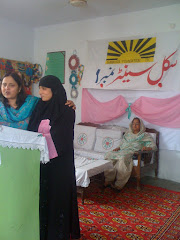MEHRGARH







Mehrgarh, (Urdu: مﮩرگڑھ , Brahui: Mehrgaŕh) one of the most important Neolithic (7000 BC to c. 2500BC) sites in archaeology, lies on what is now the "Kachi plain" of today's Balochistan, Pakistan. It is one of the earliest sites with evidence of farming (wheat and barley) and herding (cattle, sheep and goats) in
A relief map of Pakistan showing Mehrgar

Early farming village in Mehrgarh, c. 7000BCE, with houses built with mud bricks. (Musée Guimet, Paris).
The site is located near the Bolan Pass, to the west of the Indus River valley and between the present-day Pakistani cities of Quetta, Kalat and Sibi. Mehrgarh was discovered in 1974 by an archaeological team directed by French archaeologist Jean-François Jarrige, and was excavated continuously between 1974 and 1986. The earliest settlement at Mehrgarh—in the northeast corner of the 495-acre (2.00 km2) site—was a small farming village dated between 7000 BCE–5500 BCE.
Lifestyle and technology
Early Mehrgarh residents lived in mud brick houses, stored their grain in granaries, fashioned tools withlocal copper ore, and lined their large basket containers with bitumen. They cultivated six-row barley,einkorn and emmer wheat, jujubes and dates, and herded sheep, goats and cattle. Residents of the later period (5500 BCE to 2600 BCE) put much effort into crafts, including flint knapping, tanning, bead production, and metal working. The site was occupied continuously until about 2600 BCE.
In April 2006, it was announced in the scientific journal Nature that the oldest (and first early Neolithic) evidence in human history for the drilling of teeth in vivo (i.e. in a living person) was found in Mehrgarh.
Archaeological significance
Mehrgarh is now seen as a precursor to the Indus Valley Civilization. "Discoveries at Mehrgarh changed the entire concept of the Indus civilization," according to Ahmad Hasan Dani, professor emeritus of archaeology at Quaid-e-Azam University, Islamabad, "There we have the whole sequence, right from the beginning of settled village life." According to Catherine Jarrige of the Centre for Archaeological Research
"…the Kachi plain and in the Bolan basin (are) situated at the Bolan peak pass, one of the main routes connecting southern Afghanistan, eastern Iran, the Balochistan hills and the Indus River valley. This area of rolling hills is thus located on the western edge of the
The chalcolithic people of Mehrgarh also had contacts with contemporaneous cultures in northernAfghanistan, northeastern Iran and southern central Asia.
Mehrgarh Period I

A figurine from Mehrgarh, c. 3000 BCE. (Musée Guimet, Paris)
Archaeologists divide the occupation at the site into several periods. Mehrgarh Period I 7000 BCE–5500 BCE, was Neolithic and aceramic (i.e., without the use of pottery). The earliestfarming in the area was developed by semi-nomadic people using plants such as wheat andbarley and animals such as sheep, goats and cattle. The settlement was established with simple mud buildings with four internal subdivisions. Numerous burials have been found, many with elaborate goods such as baskets, stone and bone tools, beads, bangles, pendants and occasionally animal sacrifices, with more goods left with burials of males. Ornaments of sea shell, limestone, turquoise, lapis lazuli, sandstone and polished copperhave been found, along with simple figurines of women and animals. Sea shells from far sea shore and lapis lazuli found far in Badakshan, Afghanistan shows good contact with those areas. A single ground stone axe was discovered in a burial, and several more were obtained from the surface. These ground stone axes are the earliest to come from a stratified context in the South Asia.
In 2001, archaeologists studying the remains of two men from Mehrgarh made the discovery that the people of the Indus Valley Civilization, from the early Harappan periods, had knowledge of proto-dentistry. Later, in April 2006, it was announced in the scientific journal Nature that the oldest (and first early Neolithic) evidence for the drilling of human teeth in vivo (i.e. in a living person) was found in Mehrgarh. According to the authors, their discoveries point to a tradition of proto-dentistry in the early farming cultures of that region. "Here we describe eleven drilled molar crowns from nine adults discovered in a Neolithic graveyard in
Mehrgarh Period II and Period III
Mehrgarh Period II 5500 BCE–4800 BCE and Merhgarh Period III 4800 BCE–3500 BCE were ceramic Neolithic (i.e., pottery was now in use) and later chalcolithic. Much evidence of manufacturing activity has been found and more advanced techniques were used. Glazedfaience beads were produced and terracotta figurines became more detailed. Figurines of females were decorated with paint and had diverse hairstyles and ornaments. Two flexed burials were found in period II with a covering of red ochre on the body. The amount of burial goods decreased over time, becoming limited to ornaments and with more goods left with burials of females. The first button sealswere produced from terracotta and bone and had geometric designs. Technologies included stone and copper drills, updraft kilns, large pit kilns and copper melting crucibles. There is further evidence of long-distance trade in period II: important as an indication of this is the discovery of several beads oflapis lazuli—originally from Badakshan. Mehrgarh Periods II and III are also contemporaneous with an expansion of the settled populations of the borderlands at the western edge of
Mehrgarh Period VII
Somewhere between 2600 BCE and 2000 BCE, the city seems to have been largely abandoned, which is when the Indus Valley Civilisation was in its middle stages of development.











































































Such a Nice and Informative Post. Thanks for Sharing
ReplyDeletePakistan Cargo Dubai